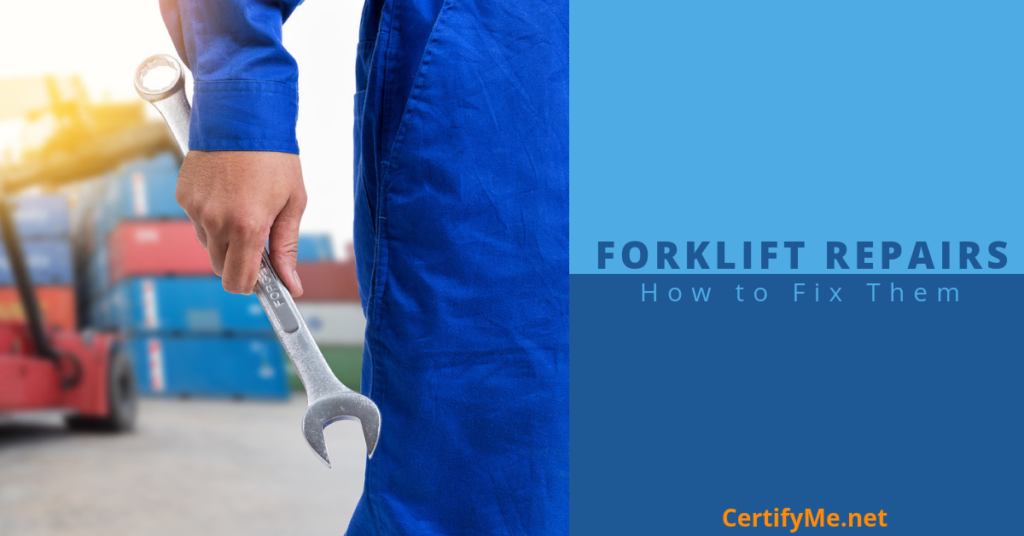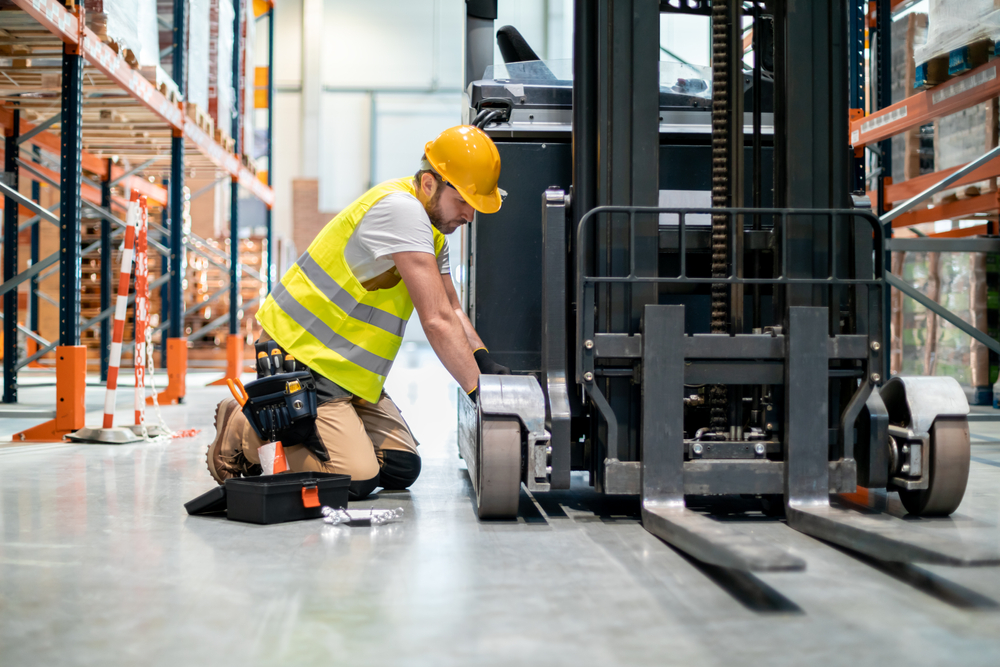How to Handle Forklift Repairs
Posted by: admin on July 31, 2022
 As workhorses of many industries, forklifts perform a variety of tasks. The most important of these is moving products and materials where they need to go in a timely and efficient manner. Today’s forklifts are well built, sturdy and durable. However, they have a lot of moving parts that get heavy use day in and day out. As with any piece of equipment in such an environment, forklift repairs are incredibly necessary over time.
As workhorses of many industries, forklifts perform a variety of tasks. The most important of these is moving products and materials where they need to go in a timely and efficient manner. Today’s forklifts are well built, sturdy and durable. However, they have a lot of moving parts that get heavy use day in and day out. As with any piece of equipment in such an environment, forklift repairs are incredibly necessary over time.
How Soon Should Repairs be Made to a Forklift?
When it comes to forklift repairs, it’s important to prioritize them as soon as you spot a problem. At a busy warehouse or job site, it can be easy to defer fixing small problems. Perhaps you don’t want the downtime while the forklift is worked on. Maybe you don’t have a needed replacement part. Sometimes you just aren’t sure how to repair a forklift.
No matter the reason, it’s always better to repair forklift problems as soon as possible. Delaying repairs can make the problem worse. This can cause more downtime for the truck and lead to costly repairs. When one part doesn’t function right it can cause problems in other areas of the forklift. Most important, delaying forklift repairs can cause permanent damage. If you wait too long to repair a forklift, the damage can become so severe that you will need to replace the lift altogether.
How Often Should Forklift Repairs be Made?
A regular forklift repair schedule is paramount. Typically, it helps to perform forklift troubleshooting and repairs approximately every 90 days. If you use your lift regularly, you may require more frequent troubleshooting and repairs.
The average lifespan of a forklift is around 10,000 to 12,000 hours. This comes to about seven years of daily use. Some high-end forklifts have a lifespan of 20,000 hours or more. Many factors can affect how long a truck lasts before needing forklift replacement. These include:
Type of Forklift
Electric forklifts tend to last longer than those powered by gas, diesel, or propane. They have fewer moving parts to wear out and need fewer repairs.
Work Application
Forklifts used in rough terrain or harsh environments are exposed to more wear and tear. This results in a shorter lifespan. Frequent accidents can also cause excess wear, which can shorten the life of a truck.
The average use of a forklift is around 2,000 hours per year. More use than that will require more frequent maintenance and forklift repairs. Forklifts that work longer shifts will wear out sooner. This is the biggest factor for the lifespan of a forklift. Nothing will extend the life of a truck more than regular scheduled maintenance.
It would seem the best time to replace a forklift is when it reaches the end of its operational life. But this isn’t always the case.
How to Repair a Forklift
Knowing how to make forklift repairs starts with understanding the problem. The three most common consist of mast, steering and starting problems.
✓ Mast Problems
The mast is the frame that controls the lifting, lowering, and tilting of the forklift. The carriage and the forks that carry loads attach to the mast. The carriage is powered by a hydraulic piston in the middle of the mast. Masts lift their loads using hydraulic power from the piston. They use gravity to lower loads. Many forklifts lift their loads in multiple stages, which can lead to a lot of things going wrong.
Common mast problems include:
- Not lifting or lowering properly
- Not lifting quick enough
- Jerky (rather than smooth) lifting and lowering
Any time you have a mast problem, first check the hydraulic fluid to make sure it isn’t low. If the oil is okay, inspect the forklift chains to see if any sections need to be replaced. Over time, mast sections can become stretched, rusted, cracked, bent, twisted or misaligned. When inspecting trucks for forklift repairs, keep an eye out for small problems that can easily become big ones.
✓ Steering Problems
Forklifts aren’t the easiest pieces of equipment to steer, especially in tight spaces. Steering problems can lead to forklift accidents that injure drivers or nearby workers. So it’s important to keep the steering functioning smoothly at all times.
Steering problems can be hard to detect. One warning sign is strange noises while that occur when turning the wheels, especially when the truck is loaded. This could indicate rust in the steering mechanism. It could also be a problem with the hydraulics that regulate steering pressure. Other steering problems include pressure valves that are loose or worn out, worn gears, low steering fluid levels, and misaligned tires.
If the steering fluid transmission is low, add more. If it’s thick and gunky, it’s time for a complete change of fluid. Problems with worn out gears or hydraulics will require an experienced mechanic to make forklift repairs.
✓ Starting Problems
A forklift that won’t start can be annoying and costly. Jobs are delayed. Items sit around waiting to be moved. Driver time is spent trying to fix the problem rather than getting work done. Fortunately, this can be a fairly easy type of forklift repair.
If you have an electric forklift, check the battery charging level. When was the last time the batter got charged? Was the procedure performed correctly? Test the lights, brakes and other auxiliary functions to see if they work. If not, you may need to fully recharge the battery. A quicker option would be to replace it with a freshly charged one if you have one available. If you have an internal combustion forklift, starting problems can be more complex. Try these forklift troubleshooting tips:
- Has fuel sat in the forklift’s tank for a long time? Old fuel may not start easily.
- Have you checked for a fuel leak? If you smell gas stronger than usual, you may have a leak.
- Have you checked the oil levels? Some forklifts won’t let the fuel valve open without enough oil in the engine.
If none of these solve the problem, check the battery. If it still has plenty of charges, check the coolant level. Overheating due to lack of coolant or radiator blockage can often prevent starting. Add coolant and/or clean the radiator if needed. If the radiator has a lot of corrosion, you may need to replace it.
Forklift Troubleshooting Tips
If you believe your forklift is not performing as well as expect, you should troubleshoot the problem. That way, you can identify any lift issues and make forklift repairs immediately.
To troubleshoot a forklift, you should:
 Take the lift out of service. Do not allow an operator to use a lift that may be malfunctioning. Instead, take the lift out of service, so it can be evaluated by a qualified technician.
Take the lift out of service. Do not allow an operator to use a lift that may be malfunctioning. Instead, take the lift out of service, so it can be evaluated by a qualified technician.- Find the source of the issue. Assess the lift to determine the root cause of the issue. Once you know why the issue is occurring, you can take steps to mitigate it.
- Ensure the repairs are performed properly. Verify that any repairs are performed by a qualified technician. Upon completion, evaluate the lift and ensure it works properly. If you notice any issues, report them to the technician and do not use the lift until they are addressed.
Forklift troubleshooting lets you detect and resolve issues in their early stages. It can be used in conjunction with forklift maintenance to ensure you can optimize the performance of your lift now and in the future.
Avoid Forklift Repairs with Regular Maintenance
Basic maintenance is one of the best ways to prevent forklift repairs. It should always be a proactive, planned event, not a reactive one. Waiting until a forklift breaks down costs time and money. Today’s warehouse management software systems make it easy to set up maintenance schedules and adhere to them. They also provide a complete maintenance and repair history of every forklift.
Daily inspections can help you stay on top of forklift repairs. Doing so can save you serious cash and help prevent accidents. When a forklift isn’t working properly, the risk of an accident goes up significantly. By inspecting your equipment before using it each day, you’ll help stop problems before they start.
If you spot a problem when performing such an inspection, immediately shift into forklift repair mode. For instance, if you spot an oil leak, or a mast that won’t go up or down, it’s important to fix them as soon as possible. Other issues are less obvious but may still impact the forklift’s performance. By determing what might happen if the problem is ignored, you can take action to prevent accidents and downtime.
Preventative Maintenance Tips for Forklifts
Taking care of your equipment can help you avoid expensive and time-consuming forklift repairs. While your organization may develop its own policies in regard to your safety program, preventative maintenance should always include:
- Check tire pressure. Underinflated tires are unsafe and reduce fuel economy. Overinflated tires can lead to blowouts and unwanted downtime. Checking tire pressure on a regular basis will save money and prevent accidents.
- Change the oil every three months. This simple maintenance task will increase fuel economy, improve forklift performance, and prevent combustion problems. It will also extend the life of the engine.
- Check antifreeze levels. A forklift without antifreeze can overheat or freeze, which can lead to major repairs. Check fluid levels and top off when needed. Inspect the reservoir for leaks.
- Don’t put off brake repairs. Replacing brake pads and calipers is a fairly easy maintenance task. These parts should be replaced at the first signs of “softness” in the brakes.
These recommendations are truly just the beginning of recommended preventative maintenance for avoiding forklift repairs. There’s another important factor to consider, too – the training and certification of your forklift operators. If your employees are caught using forklifts on the job without the proper certification, your organization may be fined thousands of dollars. Even if you manage to side step OSHA penalties, untrained workers are far more likely to be involved in a workplace accident than those who have been properly educated.
Prevent Forklift Repairs with Training from CertifyMe.net
Although we don’t offer forklift repairs near me, CertifyMe.net does offer comprehensive forklift operator training and certification. Such training can do wonders to improve safety, ensure OSHA compliance, and prevent many of the most common types of forklift repairs. A highly-trained workforce will recognize issues and adjust the way the lift is being used in order to prevent breakdowns. You’d be surprised at how effective a trained worker can be at spotting problems and minimizing downtimes.
Explore our course offerings today if you’re eager to get your team up to speed on the latest forklift best practices. Workers can sign up and complete training in about an hour’s time. Convenient, affordable, and fast, our training classes can certify workers to use up to seven classes of powered industrial trucks. Have questions about next steps? Reach out online or give us a call at 1-888-699-4800 now.
Welcome to CertifyMe.net
CertifyMe.net has offered online forklift certification since 1999. With Our Convenient online program. your employess can earn their certification in an hour or less.
Browse Online Certifications:
This low-cost program can be compeleted anytime, anywhere!






